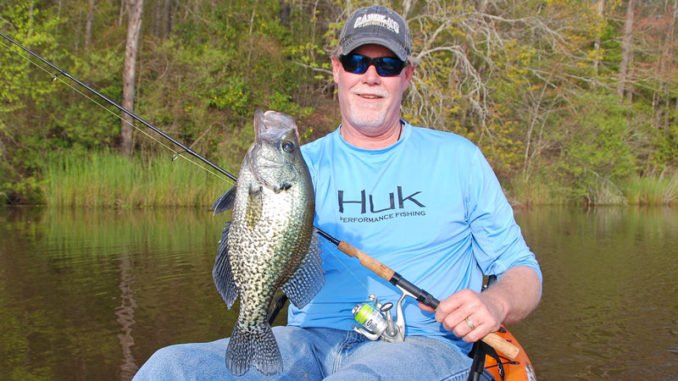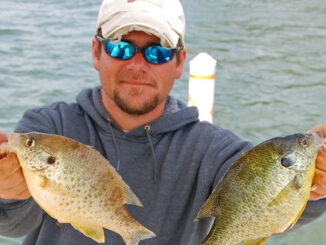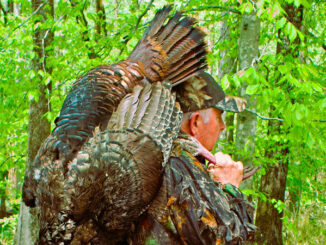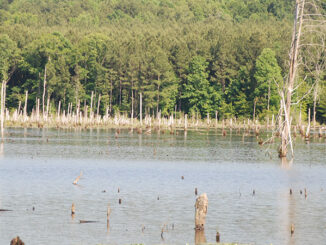
Panfish are among many “first fish” species for anglers
The likelihood is pretty high that some type of panfish tops the “first fish” list for most people. Panfish are gregarious feeders. They are not hard to catch and will generally be up for just about anything you can put on a hook. It’s rare to fish for panfish and only catch one, because many are usually present if one is. Panfish are widespread. No matter where you live in the Carolinas, at least one species of panfish thrives there.
Panfish may not offer the glory or challenge of say black bass, redfish, or even catfish, probably due to their smaller size and stature. But panfish are undeniably fun to catch. Finding a school of willing panfish on the bed, under a dock, or on a brushpile is simply a recipe for fun.
Kayak angling for panfish is no different. Being able to ply the backwaters where other anglers seldom trod is a treat in itself. Unfortunately, when such an opportunity presents itself, most kayak anglers fantasize about those larger, more prestigious species and forget about crappie, or bream, or yellow perch, warmouth, redbreasts, and the list goes on.
April is a great fishing month for nearly everything that swims, especially anything in freshwater. The Best Bet for North Carolina waters is a great example, and the recommendation is not just confined to the Tarheel State.

Overlooked waters
Chances are great that the overlooked lazy flowing rivers we cross in our vehicles on our way to some other destination harbor a species of panfish in large enough sizes and quantities to make for an unforgettable day on the water, casting tiny jigs, spinners, or bumping a wriggling redworm or squirming cricket across the bottom.
The same recommendation can be said for the South Carolina Best Bet, and the suggestion is not just limited to Santee-Cooper but any larger body of water where the transportation infrastructure has created perfect little microcosms of those larger bodies of water, removed from the main flow of boat traffic. Those cut-off ponds and sloughs may see some foot traffic, but rarely does anyone bother to drop a paddle boat into those waters and fish the remote and offshore areas the way they need to be fished.
Set aside a day or two this month to find some remote stretch of moving or static water. Pack along a small box of artificial lures with hooks no larger than No. 2 and maybe a small container of crickets, small minnows, or juicy redworms and see if you can recapture the magic of that first fish.
Best Bets
NORTH CAROLINA
WHAT — Bluegill, Shellcracker, Redbreast, Warmouth
WHERE — Slow Flowing rivers across the state. (Uwharrie, Lumber, Eno, Flat, Upper Neuse are just a few, more popular rivers)
HOW — Fish slower moving pools with hard bottom near the bank. Locate fish by casting a 1/16-ounce Beetle Spin in white, then use crickets or whole redworms on a split shot rig.
LAUNCH — Try floating from a boat ramp to the next public highway crossing or bridge to bridge.
INSIDER TIP — Shellcracker, warmouth, and yellow perch tend to feed on the bottom while crappie, bluegill, and redbreast feed up.
SOUTH CAROLINA
WHAT — Crappie, Bluegill and Shellcracker
WHERE — Santee Cooper
HOW — An underspin hair jig in 1/32- or 1/16-ounce will catch any panfish species you encounter. Cast under cypress knees and stumps found around banks and in shallow water.
LAUNCH — Find all boat landings at SanteeCooper.com.
INSIDER TIP — Both lakes are surrounded by smaller impoundments that may be cut off from the main lake by culverts or roadways and don’t get much fishing pressure. Just make sure you’re on public property.
‘Gills and ‘crackers
Although commonly lumped together in many circumstances under the handle “bream,” and sharing many common characteristics, bluegill and shellcrackers have distinctly different characteristics, especially when targeting one specific species while sportfishing.
Both species are members of the sunfish family and range statewide across both Carolinas. In addition, both species are frequently stocked in small impoundments and farm ponds, along with largemouth bass as a means of creating a balanced ecosystem in smaller bodies of water.
The species differ slightly in physical characteristics. Bluegill have an orange/yellow sheen stemming from an olive coloration while shellcrackers have a more gold/green coloration. The tip of the gill cover, or operculum is deep blue to black in bluegill and black, tipped with red or orange in shellcracker. This characteristic lends to the name “redear.”
Other differences
Both species have small mouths with no teeth on the tongue, however shellcrackers do have pharyngeal teeth located in the throat area which are used to crush the shells of snails and mussels. While both species are highly opportunistic feeders, the ability to crush prey with these teeth tends to separate the habitats of the two species.
Bluegills feed primarily on insects, invertebrates and small fish mostly near the surface. Shellcrackers feed on the bottom and prefer crayfish, mussels, snails, and insect larvae.
Both species may be found in a variety of habitat types including ponds, lakes, reservoirs, swamps, streams and small rivers.





Be the first to comment